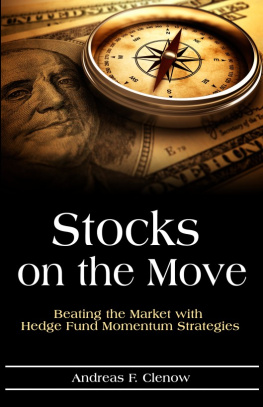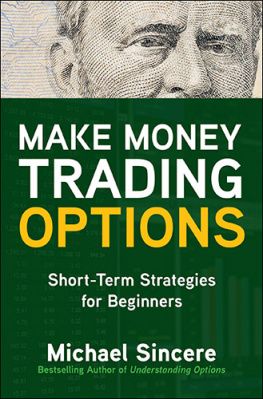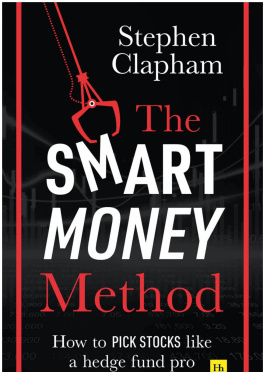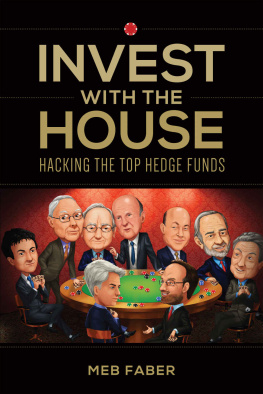Stocks on the Move
Beating the Market with Hedge FundMomentum Strategies
Andreas F. Clenow
Copyright 2015 Andreas F. Clenow
Registered Office: Equilateral CapitalManagement GmbH, Talacker 50, 8001 Zurich, Switzerland
For details of editorial policies andinformation for how to apply for permission to reuse the copyrightmaterial in this book please see our website atwww.StocksOnTheMove.net.
The right of the author to be identified asthe author of this work has been asserted in accordance with theCopyright, Designs and Patents act 1998. All rights reserved. Nopart of this publication may be reproduced, stored in a retrievalsystem, or transmitted, in any form by any means, electronic,mechanical, photocopying, teleportation, recording or otherwiseexcept as permitted by the UK Copyright, Designs and Patents Act1998, without the prior permission of the publisher. Doing so wouldmake you a very naughty boy and you dont want that, do you.
Designations used by companies to distinguishtheir products are often claimed as trademarks. All brand names andproduct names used in this book are trade names, service marks,trademarks or registered trademarks of their respective owners. Thepublisher is not associated with any product or vendor mentioned inthis book except if expressly stated.
Limit of Liability/Disclaimer of Warranty:While the publisher and the author have used their best efforts inpreparing this book, they make no representations or warrantieswith the respect to the accuracy or completeness of the contents ofthis book and specifically disclaim any implied warranties ofmerchantability or fitness for a particular purpose. It is sold onthe understanding that the publisher is not engaged in renderingprofessional services and neither the publisher nor the authorshall be liable for damages arising herefrom. If professionaladvice or other expert assistance is required, the services of acompetent professional should be sought.
ISBN: 1511466146
ISBN-13: 978-1511466141
To my brother, Mathias.
Its been a lot of fun writing this book and I hadplenty of help from some great people. The support, inspiration,comments and suggestions have been invaluable in completing thebook. In no particular order, Id like to especially thankFrederick Barnard, Julian Cohen, Philippe Hnggi, Jon Boorman,Riccardo Ronco, Didier Abato, Patrick Tan, Tom Rollinger, ErkSubasi, Kathryn Kaminksi, Raphael Rutz, Michael Bennett, FrancoisLucas, Yves Balcer, Mebane Faber, Nigol Koulajian, Greg Morris,Nitin Gupta, Nick Radge, Thomas Hackl and Larisa Sascenkova.
Preface
This is an entire book about a single tradingstrategy which can be summarized with the simple statement buystocks that move up. The idea is very simple and its certainlynot anything new. As a concept, this is old news. What this booktries to offer is a clear and systematic way of managing aportfolio of momentum stocks.
The ideas presented here are based on my ownexperience as a quantitative hedge fund manager. Ive been managinginstitutional portfolios based on this concept, as well as otherstrategies, for the past decade or so. The simple ideas are usuallythe ones that stand the test of time. That doesnt necessarily meanthat its simple to implement them, but the underlying conceptshould preferably be very simple. In this case, its really simple.A stock that has been moving up strongly for a while is likely tocontinue doing so a little bit longer. Thats the core idea. Therest is details.
I wrote a book a few years ago based onanother type of trading strategy that Ive been using for manyyears. That book was called Following the Trend and theentire book was about a very simple trend following strategy forthe futures market. When writing that book, I was quite sure thatfew would even notice it and I expected mixed reviews at best. Themain concern that I expected would be raised was that the book wasessentially a 300 page research paper. Thats absolutely valid.Thats exactly what that book was.
Much to my surprise, no one raised thatconcern. I didnt hear it once. Instead, my book took off in a waythat surprised both me and my publisher. After two years mypublisher tells me that I, against all odds, ended up in the top 5%of finance book authors. It was a fun ride and I learnt a lot alongthe way.
Momentum Investing
This book is about systematic equitymomentum. Momentum investing is a rational way to manage yourmoney, as long as youve got a protection from bear markets inplace. The problem is that its complicated to construct a solidset of rules for how to pick your stocks, when to buy them, howmuch to buy, when to sell etc. If you like to construct realisticsimulations of your trading strategies before deploying them, whichI really do recommend, momentum strategies are very complex tomodel.
Its a simple concept, but constructing asolid simulation is very difficult. The data is both expensive anddifficult to use. You need to take cash dividends, historical indexmembership, delisted stocks and other issues into account. Then youneed a simulation platform powerful enough to handle the vastamount of data needed. Ive already done that work for you. Illpresent the result to you and my analysis of it.
Of course, Ill give you enough details sothat those who do have access to the necessary tools and data canverify my work. If I didnt do that, I wouldnt have muchcredibility. Anyone can claim anything if it cant be verified.
What Ill do is to present a complete set ofrules for managing a stock momentum portfolio. It has performedvery well in the past and its very likely to continue to do so.Feel free to use it.
Why Write a Book?
This question always comes up. Why would Iwrite a book and reveal my super-secret methods to the world? Thequestion itself is based in a common misunderstanding that is oftenfound in the retail trading community. Im not revealing anythingthat hurts me or my business. A trading methodology like thisdoesnt work that way.
There are many multi-billion dollar playersin the equity momentum game. They trade according to similarprinciples that I outline in this book. Not the same, but similar.They have large research staff and they have massive budgets.Theres nothing in this book that these firms dont know or canfigure out on their own. So who should I keep these secretsfrom?
If a few thousand people read this book andstart managing their own money according to these ideas, thatsgreat. It certainly wouldnt destroy the profitability or take awaymoney from me. It just wont make a difference, considering howmuch money is already managed in momentum strategies.
If anything, Im hoping that some who readthis dont have the time or patience to implement the strategy, andinstead lets my asset management firm manage their money. Im happyto explain how everything works, but many people still need aprofessional investment manager.
So why am I writing a book? First, its quitefun. I enjoy writing and I very much enjoyed the contact I had withcountless readers after my first book. Second, theres nothingreally to lose. No secrets to give away. Hopefully my ideas areslightly better than what others have published, but were dealingin details. Third, theres the potential of finding new interestingclients for the actual business, asset management.
And if youthought that I write for the glorious revenues you get from booksales, youve obviously never written a book.
The Problem with Mutual Funds
Almost everyone in the developed world has anownership stake in a mutual fund. Even if you didnt actively buyinto any mutual fund, your pension fund is most likely invested insome of these vehicles. Mutual funds seem like a logical solutionand they have been hailed by governments, universities and banks asthe perfect solution for individuals to participate in the equitymarkets.
Next page







